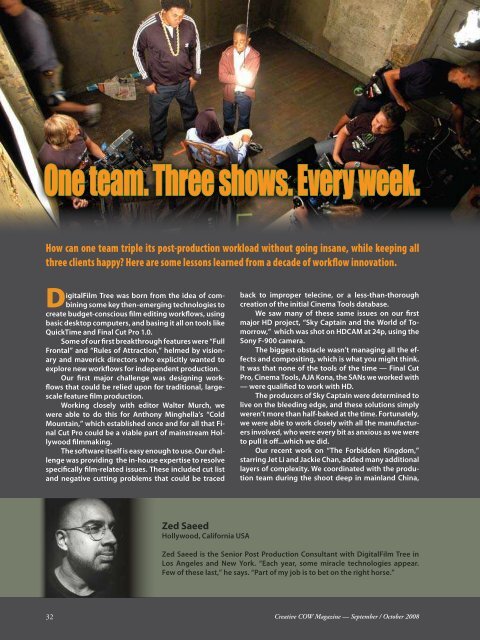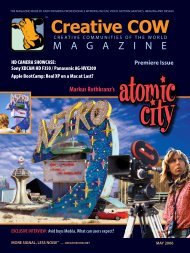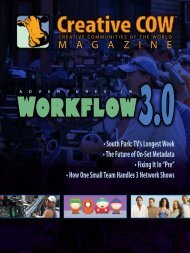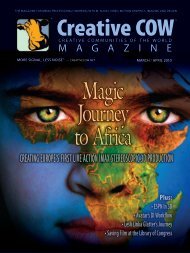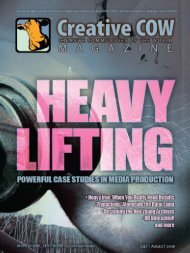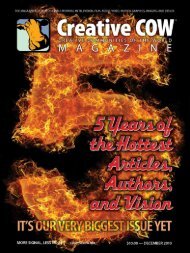Create successful ePaper yourself
Turn your PDF publications into a flip-book with our unique Google optimized e-Paper software.
One team. Three shows. Every week.<br />
How can one team triple its post-production workload without going insane, while keeping all<br />
three clients happy? Here are some lessons learned from a decade of workflow innovation.<br />
DigitalFilm Tree was born from the idea of combining<br />
some key then-emerging technologies to<br />
create budget-conscious film editing workflows, using<br />
basic desktop computers, and basing it all on tools like<br />
QuickTime and Final Cut Pro 1.0.<br />
Some of our first breakthrough features were “Full<br />
Frontal” and “Rules of Attraction,” helmed by visionary<br />
and maverick directors who explicitly wanted to<br />
explore new workflows for independent production.<br />
Our first major challenge was designing workflows<br />
that could be relied upon for traditional, largescale<br />
feature film production.<br />
Working closely with editor Walter Murch, we<br />
were able to do this for Anthony Minghella’s “Cold<br />
Mountain,” which established once and for all that Final<br />
Cut Pro could be a viable part of mainstream Hollywood<br />
filmmaking.<br />
The software itself is easy enough to use. Our challenge<br />
was providing the in-house expertise to resolve<br />
specifically film-related issues. These included cut list<br />
and negative cutting problems that could be traced<br />
Zed Saeed<br />
Hollywood, California USA<br />
back to improper telecine, or a less-than-thorough<br />
creation of the initial Cinema Tools database.<br />
We saw many of these same issues on our first<br />
major HD project, “Sky Captain and the World of Tomorrow,”<br />
which was shot on HDCAM at 24p, using the<br />
Sony F-900 camera.<br />
The biggest obstacle wasn’t managing all the effects<br />
and compositing, which is what you might think.<br />
It was that none of the tools of the time — Final Cut<br />
Pro, Cinema Tools, AJA Kona, the SANs we worked with<br />
— were qualified to work with HD.<br />
The producers of Sky Captain were determined to<br />
live on the bleeding edge, and these solutions simply<br />
weren’t more than half-baked at the time. Fortunately,<br />
we were able to work closely with all the manufacturers<br />
involved, who were every bit as anxious as we were<br />
to pull it off...which we did.<br />
Our recent work on “The Forbidden Kingdom,”<br />
starring Jet Li and Jackie Chan, added many additional<br />
layers of complexity. We coordinated with the prodution<br />
team during the shoot deep in mainland China,<br />
Zed Saeed is the Senior Post Production Consultant with DigitalFilm Tree in<br />
Los Angeles and New York. “Each year, some miracle technologies appear.<br />
Few of these last,” he says. “Part of my job is to bet on the right horse.”<br />
Cinematographer Peter Pau with Jet Li (left) and Jackie Chan (right) on<br />
location deep in mainland China for “The Forbidden Kingdom.”<br />
where our responsibilities included making tape backups<br />
of the Panavision Genesis RAW files, and placing<br />
them physically in a safe to satisfy the insurance bond.<br />
We also coordinated a post team spread across China,<br />
the US, Korea and Australia.<br />
[Editor’s note: Zed wrote a full article for <strong>Creative</strong>Cow.<br />
net covering every aspect of this remarkable production.<br />
You can find it at http://library.creativecow.net/forbidden_<br />
kingdom.php]<br />
All of this put us in the right place, at the right<br />
time, to work with Final Cut Pro in the world of episodic<br />
production: all of the challenges of film production,<br />
now applied to the creation of two dozen “short films,”<br />
non-stop.<br />
Episodic work brings so much more pressure that<br />
it’s no wonder that the same studios who signed off on<br />
Final Cut Pro-produced movies weren’t ready to use it<br />
on their TV shows.<br />
The pressure on us: the same team of nine that<br />
used to post one episode of a single show each week<br />
now becoming responsible for posting three different<br />
network TV series, every week, at the same time.<br />
SCRUBS<br />
We helped the medical comedy “Scrubs” become the<br />
first major TV series to be onlined in Final Cut Pro,<br />
starting in their second season. By the next season, we<br />
took on the role of consultants and created, designed<br />
and implemented an on-site Xsan system and network<br />
for two editors and two assistant editors.<br />
Even though “Scrubs” originates on super 16mm,<br />
the final air master is delivered on Digital Betacam. At<br />
the same time, the studio requires film cut lists in case<br />
of a future film negative cut, which means that we had<br />
to build that into the workflow as well.<br />
We offline QuickTime files<br />
from the dailies we process.<br />
These are sent to the Scrubs editorial<br />
for a creative edit. The Final<br />
Cut Pro project files are then<br />
emailed back to us for online<br />
and finishing.<br />
Our work has expanded to<br />
all post services, including visual<br />
effects. It is no small honor that<br />
Jon Michel won the 2005 Emmy<br />
for Outstanding Multi-camera<br />
Editing for his work on Scrubs<br />
Along with a move from<br />
NBC to ABC, “Scrubs” will also<br />
be moving from film to HD. The<br />
HD transition has the reputation<br />
for being difficult, but<br />
compared to film, it’s a breeze.<br />
One of the things you can’t<br />
see as a viewer is that we’re<br />
carefully preparing the Cinema<br />
Tools databases and linking<br />
them to the QT files as<br />
we go, totally conformed to<br />
match back for film integrity. That is, we have to<br />
confirm every single clip against the edge code, so<br />
that when going back to the sources for later cuts,<br />
producers can actually find the clips they need.<br />
Now, with HD, the only thing we have to<br />
Zach Braff, “Scrubs”<br />
worry about is timecode. We capture video, we output<br />
video, end of story<br />
THE GREAT FLOOD<br />
Every post house has its challenges, but nothing prepared<br />
us for what we call “The Great Flood of 2005.”<br />
We came in one morning to find over 6 inches of water<br />
across the entire facility. Let me tell you, walking from<br />
32 <strong>Creative</strong> <strong>COW</strong> <strong>Magazine</strong> — September / October 2008<br />
<strong>Creative</strong> <strong>COW</strong> <strong>Magazine</strong> — September / October 2008 33


